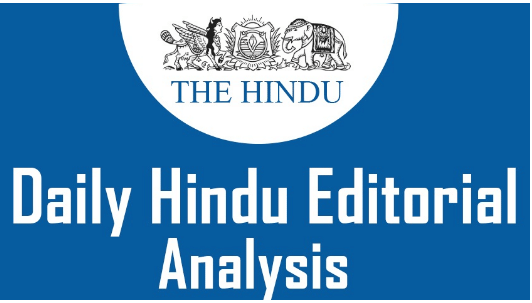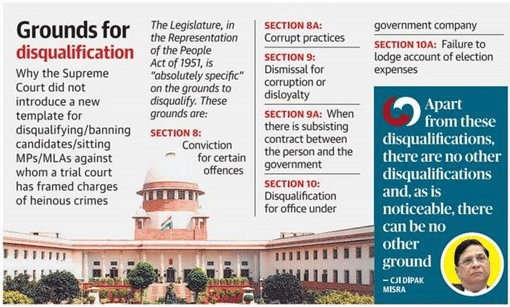The Hindu Editorial Analysis- 12th November, 2020 | Additional Study Material for UPSC PDF Download

1. ELECTORAL REFORMS-
GS 2- Comparison of the Indian constitutional scheme with that of other countries
Context:
(i) In the recently concluded presidential election in the U.S., the delay in announcing the result and issue of denial of the election results by the incumbent has brought into focus the role played by flaws(errors) in the Americal democratic system in the conduct of the election.
(ii) This article compares the powers of the elections bodies in the U.S. and India.

Powers Of ECI
(i) Indian Constitution has given the ECI enormous power to be exercised during the course of elections, and strictly on other election-related matters.
(ii) By virtue of being the custodian of the electoral roll, all matters related to keeping the roll updated, fall under the ECI’s domain.
(iii) Even the higher judiciary does not interfere during the course of the election process.
(iv) Our Constitution’s fathers decided to limit the role of the judiciary in India to the post-election period, when election petitions may be filed.
(v) This was done to avoid the impeding of the election process and delay election results interminably.
Comparing The Powers
(i) The U.S. Federal Election Commission has a much narrower mandate than its Indian equivalent-Election Commission of India.
(ii) The Federal Election Commission was established comparatively recently — 1975, with the special mandate to regulate campaign finance issues.
(iii) As a watchdog, it is meant to disclose campaign finance information, to enforce the law regarding campaign contributions, and oversee public funding of the presidential election.
(iv) The Federal Election Commission is led by six Commissioners.
(v) These six posts are supposed to be equally shared by Democrats and Republicans, and too have to be confirmed by the Senate.
(vi) This leads to decision making divided on partisan lines.
What India Can Learn From The Election Process In The U.S.?
(i) In the 2016 U.S. election, almost a quarter of the votes counted arose from postal and early balloting.
(ii) In India we have confined postal ballots to only a few categories, of largely government staff (for example those on election duty) as well as the police or armed forces.
(iii) In these difficult times of the novel coronavirus pandemic, we need to widen this base to include all senior citizens and anyone else who may find it convenient to cast their vote early.
Conclusion
In its functioning, Election Commission of India has broad powers as compared to its counterpart in the U.S. which has helped India see a smooth power transfer from the first election in India in 1951-52 and every single election since.
2. ELECTION EXPENDITURE AND ASSOCIATED ISSUES-
GS 2- Salient features of the Representation of People’s Act
Context
The Law Ministry has increased the ceiling(limit) on poll expenditure for Assembly and Lok Sabha elections by 10% following a recommendation by the Election Commission in view of curbs(restrictions) imposed during the coronavirus pandemic.

New Ceiling On Poll Expenditure
(i) The ceiling on poll expenditure varies across States, with candidates in Assembly elections in bigger States like Bihar, Uttar Pradesh, and Tamil Nadu now allowed to spend up to ₹30.8 lakhs as against ₹28 lakhs earlier.
(ii) For a candidate contesting a Lok Sabha poll in these States, the revised ceiling on poll expenditure is now ₹77 lakhs instead of the earlier amount of ₹70 lakhs.
(iii) Goa, Arunachal Pradesh, Sikkim and a few Union Territories, based on the size of their constituencies and population, have a lower ceiling on poll expenditure.
(iv) Here while the enhanced ceiling for a Lok Sabha candidate is now ₹59.4 lakhs those contesting an Assembly can spend up to ₹22 lakhs.
How Are Such Ceilings Made?
(i) Such changes are made by amending the Conduct of Elections Rules.
(ii) The last time the expenditure ceiling was enhanced was in 2014 just ahead of the Lok Sabha polls.
What Doesn’t Account To Election Expenditure?
(i) The expenditure incurred by leaders of a political party on account of travel by air or by any other means of transport for propagating programme of the political party is not considered to be the election expenditure.
(ii) Any expenditure which is done for service of the Government and discharge of official duty is also not considered to be election expenditure.
Role Of Election Commission
(i) The EC imposes limits on campaign expenditure incurred by a candidate and not political parties.
(ii) However, it does not cover expenses incurred either by a party or the leader of a party for propagating the party’s programme.
(iii) Also, candidates must mandatorily file a true account of election expenses with the EC.
(iv) An incorrect account or expenditure beyond the ceiling can attract disqualification for up to three years as per Section 10A of The Representation of the People Act, 1951.
3. EXPLORING THE IDEA OF BLOCKCHAIN VOTING-
GS 3- Awareness in the fields of IT, Space, Computers, robotics, nano-technology, bio-technology
Context
(i) The Election Commission of India has been exploring the idea of further digitising the electoral infrastructure of the country.
(ii) In furtherance of this, it explored the possibility of using blockchain technology for the purpose of enabling remote elections.
What Will Be The Benefits?
(i) ‘Remote voting’ would appear to benefit internal migrants and seasonal workers, who account for roughly 51 million of the populace (Census 2011).
(ii) The envisioned solution might also be useful for some remotely-stationed members of the Indian armed forces.
Key Issues
(i) Electors would still have to physically reach a designated venue in order to cast their vote.
(ii) Digitisation and interconnectivity introduce additional points of failure external to the processes which exist in the present day.
(iii) Blockchain solutions rely heavily on the proper implementation of cryptographic protocols.
(iv) If security is breached, it could unmask the identity and voting preferences of electors, or worse yet, allow an individual to cast a vote as someone else.
(v) The provisioning of a dedicated line may make the infrastructure less prone to outages, it may also make it increasingly prone to targeted Denial-of-Service attack.
(vi) Digitised systems may also stand to exclude and disenfranchise certain individuals due to flaws in interdependent platforms, flaws in system design, as well as general failures caused by external factors.
Way Forward
(i) Political engagement could perhaps be improved by introducing and improving upon other methods, such as postal ballots or proxy voting.
(ii) Another proposed solution to this issue includes the creation of a ‘One Nation, One Voter ID’ system.
Conclusion
(i) Adoption of technology should be weighed against the risk it carries in the electoral process.
(ii) While the adoption of blockchain technology offers many opportunities, the concerns it raises must be addressed before its adoption.
|
21 videos|562 docs|160 tests
|
FAQs on The Hindu Editorial Analysis- 12th November, 2020 - Additional Study Material for UPSC
| 1. What is the significance of The Hindu Editorial Analysis for UPSC exam preparation? |  |
| 2. How can The Hindu Editorial Analysis help in improving language skills for the UPSC exam? |  |
| 3. What are the key benefits of reading The Hindu Editorial Analysis for the UPSC exam? |  |
| 4. How can The Hindu Editorial Analysis contribute to the preparation of the UPSC Mains exam? |  |
| 5. Where can one access The Hindu Editorial Analysis for UPSC exam preparation? |  |
















